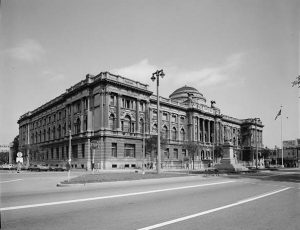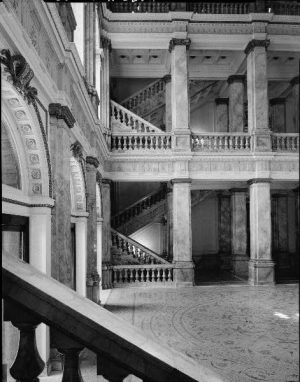Early migrants from the northeastern United States and from Germany were responsible for the creation of libraries in Milwaukee. In 1842, Philetus C. Hale, originally from Massachusetts, opened the first bookstore in Milwaukee as well as the city’s first subscription library.[1] Subscription libraries were a type of social library common throughout the eastern United States in the 1800s. Patrons could pay annual dues to subscribe to a library, borrow books from its collection, and use its reading room.
Prior to the mid-1800s, Yankee migrants from the eastern U.S., like Hale, formed the largest ethnic group in Milwaukee.[2] The Yankee settlers from the east coast brought with them ideas about public education, including library development. By the mid-nineteenth century, Milwaukee was also experiencing an influx of German immigrants. What had been predominantly a Yankee settlement quickly transitioned to a city immersed in German culture. Milwaukee’s ethnic composition played a unique role in the development of the public library. According to one historian of the city, “The early settlers of Milwaukee, whether Yankee or European, came from regions where public-supported…education was held in high repute.”[3]
Yet public library development in Milwaukee rested primarily in the hands of Yankees who dominated social and subscription library associations.[4] The Milwaukee Daily Sentinel opened a reading room in 1845, which provided access to newspapers from throughout the United States.[5] The newspaper also initiated public discussion about a library: “We doubt whether there is another place in the Union, containing as large a population as Milwaukie [sic], destitute of a good reading room. Indeed, most other places, as large as this, have a good public library connected with a reading room.”[6]
Milwaukee Daily Sentinel editor Rufus King used the newspaper to raise awareness and support for a library. In 1847, Milwaukee unveiled a plan to close all of the city’s stores by 8:00 p.m. so that young store clerks would have time to “improve themselves.” King advocated for a public library in which those men could spend their time.[7] On December 7, 1847, the Milwaukee Daily Sentinel organized a meeting to form the Young Men’s Association.[8] Members of the new association paid annual dues, and in 1848, $1,250 was raised to operate a subscription library.[9] Increase Lapham, Rufus King, and Leander Comstock played key roles in building the Association’s library.[10]
By 1871, the Young Men’s Association had over 2,500 members and the library had nearly 10,000 volumes.[11] As the decade wore on, however, the Association experienced declining membership and financial difficulties, and the library had been struck by fire twice, which destroyed much of the collection.[12]
As the Association faded, Wisconsin passed the Public Library Act of 1872, which authorized communities to build public libraries that could be supported with tax dollars. The decline of the Young Men’s Association also coincided with the Public Library Movement which was sweeping the country, and “Milwaukee, too, felt the impulse” to build a public library.[13] Civic pride also played a role. Chicago opened its public library in 1873, which prompted the Milwaukee Daily Sentinel to ask its readers when Milwaukee would have a public library.[14]
In 1877, the Young Men’s Association offered their library to the city, and the Milwaukee Common Council passed a motion to use the collection to establish a free public library.[15] In 1878, MPL opened. By 1880, more space was needed. After another fire destroyed part of the collection, the city decided to construct a new building to house the library and a public museum. The new building, which is still in use today, opened in 1898, although the museum has since moved to another location.[16]
Throughout the twentieth century, MPL expanded and offered services to outlying communities in the area through the provision of bookmobiles and renting out its collection. It also allowed users from outside of Milwaukee to obtain library cards and borrow books in exchange for a fee which was paid by outlying communities.
MPL has opened thirteen branch locations throughout the city: Atkinson, Bay View, Capitol, Center Street, East, Forest Home, Martin Luther King, Mill Road, Tippecanoe, Villard Square, Washington Park, Zablocki, and MPL Express at Silver Spring, located in the heart of Wisconsin’s largest public housing development. MPL Express at Silver Spring is unique in that it provides 24-hour access to books in the collection through innovative technology. MPL provides additional physical access to its collection through its regularly scheduled van services to seventeen locations throughout the city.
Services at MPL have also expanded over the decades. In addition to allowing patrons to borrow books, magazines, music CDs, videos, and other materials from its collection, MPL offers computer classes, English as a Second Language resources, educational classes, copying services, tutoring, job-seeking resources, and meeting space. MPL also offers a wide range of online resources, including research databases, digital collections, and library updates through its blogs.
MPL has responded to ongoing user needs and is viewed in a positive light by the community. Over 91 percent of Milwaukee residents rated the quality of the library as good or excellent, whether they used the library or not.[17] This has boded well for funding support from the city.[18] Like other libraries in the region, MPL has an active Friends Association and Foundation to support the library. MPL’s 2020 strategic plan indicates three areas of future focus based on the city’s demographics and MPL users: a) families with young children, b) recent immigrants, and c) middle-aged, long-term Milwaukee residents.
From its roots as the subscription library of the Young Men’s Association over a century ago, MPL has grown to an institution serving hundreds of thousands of patrons and with over 2.7 million books and archival materials and 1.5 million government documents in its collection.[19]
Footnotes [+]
- ^ Alice E. Smith, From Exploration to Statehood: History of Wisconsin (Stevens Point, WI: Wisconsin Historical Society, 2013), 564.
- ^ Bayrd Still, Milwaukee: The History of a City (Madison: State Historical Society of Wisconsin, 1948), 70.
- ^ Still, Milwaukee, 81.
- ^ John Gurda, “My Library—The Evolution of a Milwaukee Institution,” Marquette Lawyer (Summer 2016): 48.
- ^ “City Matters,” Milwaukee Daily Sentinel, February 27, 1845.
- ^ “City Matters,” Milwaukee Daily Sentinel, February 27, 1845.
- ^ “City Matters,” Milwaukee Daily Sentinel, December 6, 1847.
- ^ “Young Men’s Association Meeting,” Milwaukee Daily Sentinel, December 7, 1847.
- ^ Meeting Minutes, Young Men’s Association of the City of Milwaukee, 1848-1868, Milwaukee Manuscript Collection, Wisconsin Historical Society.
- ^ Gurda, “My Library,” 49.
- ^ Gurda, “My Library,” 49.
- ^ “History of the Milwaukee Public Library,” accessed September 16, 2015.
- ^ Gurda, “My Library,” 48-49.
- ^ “City Matters,” Milwaukee Daily Sentinel, November 5, 1873.
- ^ “Proceedings of the Common Council and Ordinances of the City of Milwaukee,” Milwaukee: Common, Council, 1877-1880.
- ^ “History of the Milwaukee Public Library,” accessed September 16, 2015.
- ^ Institute for Survey and Policy Research, Social and Political Survey (Milwaukee: University of Wisconsin-Milwaukee, 1996).
- ^ “Budget Summaries,” City of Milwaukee, 1960-2000.
- ^ “Central Library,” Milwaukee Public Library, accessed November 20, 2014.
For Further Reading
Banda, Anne E. A Tale of Two Cities: Public Library Development in Milwaukee and Montreal. Germany: VDM Verlag, 2009.
Colson, John. “Public Library Movement in Wisconsin, 1836-1900.” PhD diss., University of Chicago, 1973.
Elmendorf, Theresa West. History of Milwaukee Public Library. Milwaukee: State Committee on Educational Exhibition for Wisconsin, 1893.
Harris, Michael, ed. Reader in American Library History. Washington, DC: National Cash Register Company, 1971.
Stone, Elizabeth W. American Library Development, 1600-1899. New York: Wilson, 1977.
Wiegand, Wayne A., and Donald G. Davis, Jr., eds. Encyclopedia of Library History. New York: Garland, 1994.



0 Comments
Please keep your community civil. All comments must follow the Encyclopedia of Milwaukee Community rules and terms of use, and will be moderated prior to posting. Encyclopedia of Milwaukee reserves the right to use the comments we receive, in whole or in part, and to use the commenter's name and location, in any medium. See also the Copyright, Privacy, and Terms & Conditions.
Have a suggestion for a new topic? Please use the Site Contact Form.